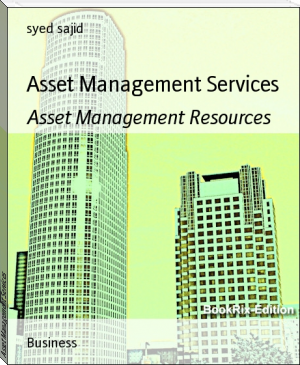Asset Management Services, syed sajid [best novels in english .TXT] 📗

- Author: syed sajid
Book online «Asset Management Services, syed sajid [best novels in english .TXT] 📗». Author syed sajid
Asset Management Services
Abstract
Services that keep inventory, track of hardware and software assets and licenses and management a customer's management of technology assets procurement or leasing assets. The business of investment management has several facets, including the employment of professional fund managers, research (of individual assets and asset classes), dealing, settlement, marketing, internal auditing, and the preparation of reports for clients. The largest financial fund managers are firms that exhibit all the complexity their size demands. Apart from the people who bring in the money (marketers) and the people who direct investment (the fund managers), there are compliance staff (to ensure accord with legislative and regulatory constraints), internal auditors of various kinds (to examine internal systems and controls), financial controllers (to account for the institutions' own money and costs), computer experts, and "back office" employees (to track and record transactions and fund valuations for up to thousands of clients per institution).
Asset Management Resources
For businesses from foundries to pharmaceuticals, tracking a complex fixed asset inventory isn’t simple without asset management resources. That’s probably why most businesses don’t have an accurate accounting of their fixed assets – costing billions of dollars each year in tax overpayment, regulatory non-compliance, and inefficiency
Our clients in the Asset Management space typically service institutional clients, private investors, as well as retail markets. We specialize in the buy side market space and have several leading, global Asset Managers and Custodian Banks as our clients.
We work across all security types including Equity, Fixed Income, Derivatives and Cash Instruments in supporting the front-office, middle office and back office operations.
Asset Management Resources core services
Fixed asset consulting services, featuring wall-to-wall fixed asset inventory and reconciliation (FAIR)
Personal property tax for businesses- management and consulting to reduce tax liability Expert cost segregation and fixed asset consulting services to maximize exempt allowances and incorporate
proper depreciation schedules
Investment management is the professional management of various securities (shares, bonds and other securities) and assets (e.g., real estate), to meet specified investment goals for the benefit of the investors. Investors may be institutions (insurance companies, pension funds, corporations etc.) or private investors (both directly via investment contracts and more commonly via collective investment schemes e.g. mutual funds or exchange-traded funds) .
The term asset management is often used to refer to the investment management of collective investments, (not necessarily) whilst the more generic fund management may refer to all forms of institutional investment as well as investment management for private investors. Investment managers who specialize in advisory or discretionary management on behalf of (normally wealthy) private investors may often refer to their services as wealth management or portfolio management often within the context of so-called "private banking".
The provision of 'investment management services' includes elements of financial statement analysis, asset selection, stock selection, plan implementation and ongoing monitoring of investments. Investment management is a large and important global industry in its own right responsible for caretaking of trillions of dollars, euro, pounds and yen. Coming under the remit of financial services many of the world's largest companies are at least in part investment managers and employ millions of staff and create billions in revenue.
Fund manager (or investment adviser in the United States) refers to both a firm that provides investment management services and an individual who directs fund management decisions
Key problems of running such businesses
Key problems include:
• revenue is directly linked to market valuations, so a major fall in asset prices causes a precipitous decline in revenues relative to costs;
• above-average fund performance is difficult to sustain, and clients may not be patient during times of poor performance;
• successful fund managers are expensive and may be headhunted by competitors;
• above-average fund performance appears to be dependent on the unique skills of the fund manager; however, clients are loath to stake their investments on the ability of a few individuals- they would rather see firm-wide success, attributable to a single philosophy and internal discipline;
• analysts who generate above-average returns often become sufficiently wealthy that they avoid corporate employment in favor of managing their personal portfolios.
The most successful investment firms in the world have probably been those that have been separated physically and psychologically from banks and insurance companies[citation needed]. That is, the best performance and also the most dynamic business strategies (in this field) have generally come from independent investment management firms[citation needed].
[edit] Representing the owners of shares
Institutions often control huge shareholdings. In most cases they are acting as fiduciary agents rather than principals (direct owners). The owners of shares theoretically have great power to alter the companies they own via the voting rights the shares carry and the consequent ability to pressure managements, and if necessary out-vote them at annual and other meetings.
In practice, the ultimate owners of shares often do not exercise the power they collectively hold (because the owners are many, each with small holdings); financial institutions (as agents) sometimes do. There is a general belief that shareholders - in this case, the institutions acting as agents—could and should exercise more active influence over the companies in which they hold shares (e.g., to hold managers to account, to ensure Boards effective functioning). Such action would add a pressure group to those (the regulators and the Board) overseeing management.
However there is the problem of how the institution should exercise this power. One way is for the institution to decide, the other is for the institution to poll its beneficiaries. Assuming that the institution polls, should it then: (i) Vote the entire holding as directed by the majority of votes cast? (ii) Split the vote (where this is allowed) according to the proportions of the vote? (iii) Or respect the abstainers and only vote the respondents' holdings?
The price signals generated by large active managers holding or not holding the stock may contribute to management change. For example, this is the case when a large active manager sells his position in a company, leading to (possibly) a decline in the stock price, but more importantly a loss of confidence by the markets in the management of the company, thus precipitating changes in the management team.
Some institutions have been more vocal and active in pursuing such matters; for instance, some firms believe that there are investment advantages to accumulating substantial minority shareholdings (i.e. 10% or more) and putting pressure on management to implement significant changes in the business. In some cases, institutions with minority holdings work together to force management change. Perhaps more frequent is the sustained pressure that large institutions bring to bear on management teams through persuasive discourse and PR. On the other hand, some of the largest investment managers—such as Barclays Global Investors and Vanguard—advocate simply owning every company, reducing the incentive to influence management teams. A reason for this last strategy is that the investment manager prefers a closer, more open and honest relationship with a company's management team than would exist if they exercised control; allowing them to make a better investment decision.
The national context in which shareholder representation considerations are set is variable and important. The USA is a litigious society and shareholders use the law as a lever to pressure management teams. In Japan it is traditional for shareholders to be low in the 'pecking order,' which often allows management and labor to ignore the rights of the ultimate owners. Whereas US firms generally cater to shareholders, Japanese businesses generally exhibit a stakeholder mentality, in which they seek consensus amongst all interested parties (against a background of strong unions and labour legislation).
Size of the global fund management industry
Conventional assets under management of the global fund management industry fell 19% in 2008, to $61.6 trillion. Pension assets accounted for $24.0 trillion of the total, with $18.9 trillion invested in mutual funds and $18.7 trillion in insurance funds. Together with alternative assets (sovereign wealth funds, hedge funds, private equity funds and exchange traded funds) and funds of wealthy individuals, assets of the global fund management industry totalled around $90 trillion at the end of 2008, a fall of 17% on the previous year. The decline in 2008 followed five successive years of growth during which assets under management more than doubled. Falls on equity markets, poor investment performance, reduced inflow of new funds, and investor redemptions, all contributed to the fall in assets in 2008. The decline reported in US dollars was also exacerbated by the strengthening of the US dollar during the year.
The US remained by far the biggest source of funds, accounting for over a half of conventional assets under management in 2008 or over $30 trillion. The UK was the second largest centre in the world and by far the largest in Europe with around 9% of the global total.[1]
Largest Asset Management Firms
JP Morgan & Chase (2.2T) State Street Global Advisors (1.9T) Bank of America/Merrill Lynch (1.5T) has overtaken UBS (1.4T) as the largest global wealth management firm, with Citi (1.3T) still in sight.[2]
Philosophy, process and people
The 3-P's (Philosophy, Process and People) are often used to describe the reasons why the manager is able to produce above average results.
• Philosophy refers to the over-arching beliefs of the investment organization. For example: (i) Does the manager buy growth or value shares (and why)? (ii) Do they believe in market timing (and on what evidence)? (iii) Do they rely on external research or do they employ a team of researchers? It is helpful if any and all of such fundamental beliefs are supported by proof-statements.
• Process refers to the way in which the overall philosophy is implemented. For example: (i) Which universe of assets is explored before particular assets are chosen as suitable investments? (ii) How does the manager decide what to buy and when? (iii) How does the manager decide what to sell and when? (iv) Who takes the decisions and are they taken by committee? (v) What controls are in place to ensure that a rogue fund (one very different from others and from what is intended) cannot arise?
• People refers to the staff, especially the fund managers. The questions are, Who are they? How are they selected? How old are they? Who reports to whom? How deep is the team (and do all the members understand the philosophy and process they are supposed to be using)? And most important of all, How long has the team been working together? This last question is vital because whatever performance record was presented at the outset of the relationship with the client may or may not relate to (have been produced by) a team that is still in place. If the team has changed greatly (high staff turnover or changes to the team), then arguably the performance record is completely unrelated to the existing team (of fund managers).
Investment managers and portfolio structures
At the heart of the investment management industry are the managers who invest and divest client investments.
A certified company investment advisor should conduct an assessment of each client's individual needs and risk profile. The advisor then recommends appropriate investments.
Asset allocation
The different asset class definitions are widely debated, but four common divisions are stocks, bonds, real-estate and commodities. The exercise of allocating funds among these assets (and among individual securities within each asset class) is what investment management firms are paid for. Asset classes exhibit different market dynamics, and different interaction effects; thus, the allocation of money among asset classes will have a significant





Comments (0)